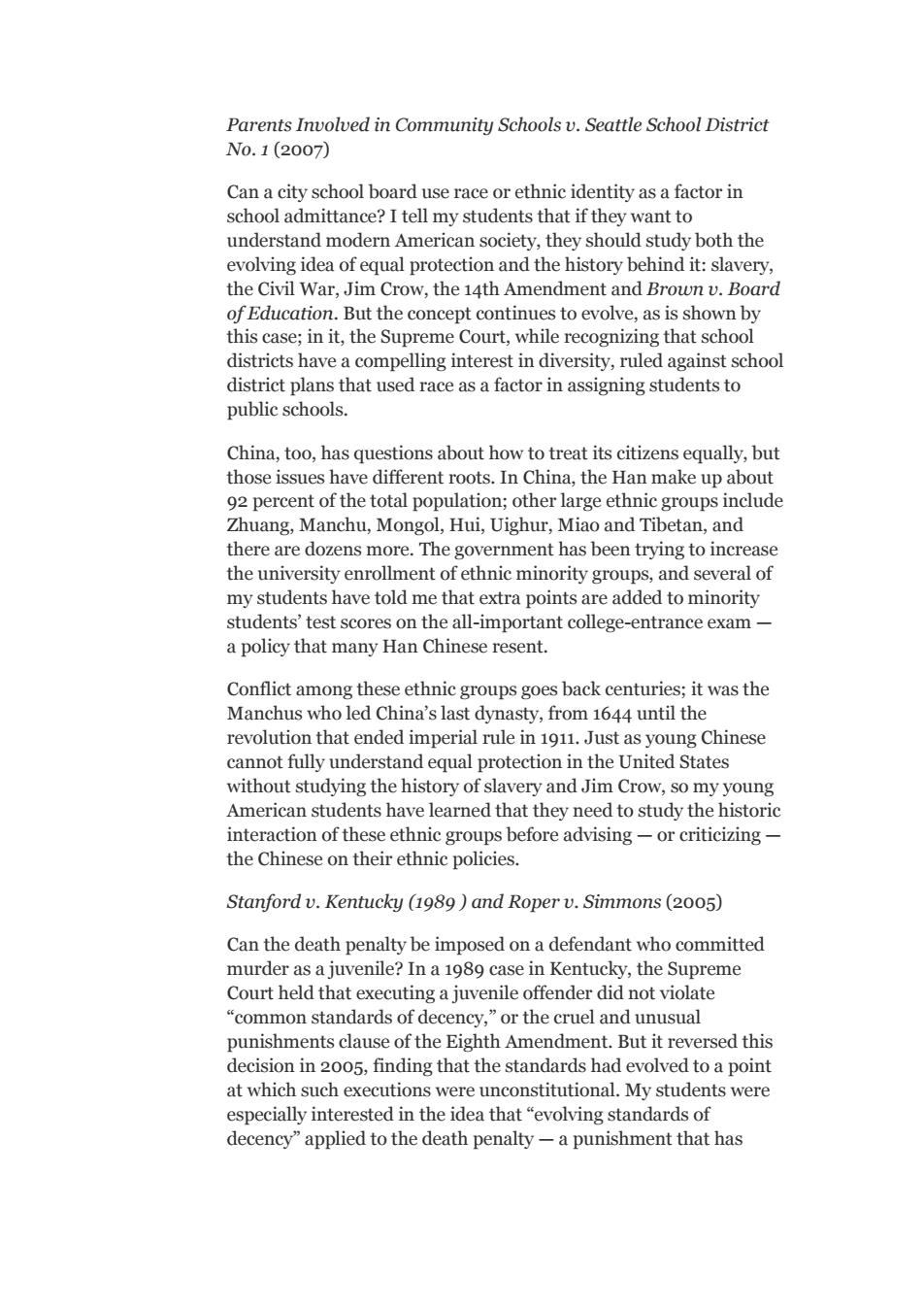正在加载图片...

Parents Involved in Community Schools v.Seattle School District No.1(2007) Can a city school board use race or ethnic identity as a factor in school admittance?I tell my students that if they want to understand modern American society,they should study both the evolving idea of equal protection and the history behind it:slavery, the Civil War,Jim Crow,the 14th Amendment and Brown v.Board of Education.But the concept continues to evolve,as is shown by this case;in it,the Supreme Court,while recognizing that school districts have a compelling interest in diversity,ruled against school district plans that used race as a factor in assigning students to public schools. China,too,has questions about how to treat its citizens equally,but those issues have different roots.In China,the Han make up about 92 percent of the total population;other large ethnic groups include Zhuang,Manchu,Mongol,Hui,Uighur,Miao and Tibetan,and there are dozens more.The government has been trying to increase the university enrollment of ethnic minority groups,and several of my students have told me that extra points are added to minority students'test scores on the all-important college-entrance exam- a policy that many Han Chinese resent. Conflict among these ethnic groups goes back centuries;it was the Manchus who led China's last dynasty,from 1644 until the revolution that ended imperial rule in 1911.Just as young Chinese cannot fully understand equal protection in the United States without studying the history of slavery and Jim Crow,so my young American students have learned that they need to study the historic interaction of these ethnic groups before advising-or criticizing- the Chinese on their ethnic policies. Stanford v.Kentucky (1989)and Roper v.Simmons(2005) Can the death penalty be imposed on a defendant who committed murder as a juvenile?In a 1989 case in Kentucky,the Supreme Court held that executing a juvenile offender did not violate "common standards of decency,"or the cruel and unusual punishments clause of the Eighth Amendment.But it reversed this decision in 2005,finding that the standards had evolved to a point at which such executions were unconstitutional.My students were especially interested in the idea that"evolving standards of decency"applied to the death penalty-a punishment that hasParents Involved in Community Schools v. Seattle School District No. 1 (2007) Can a city school board use race or ethnic identity as a factor in school admittance? I tell my students that if they want to understand modern American society, they should study both the evolving idea of equal protection and the history behind it: slavery, the Civil War, Jim Crow, the 14th Amendment and Brown v. Board of Education. But the concept continues to evolve, as is shown by this case; in it, the Supreme Court, while recognizing that school districts have a compelling interest in diversity, ruled against school district plans that used race as a factor in assigning students to public schools. China, too, has questions about how to treat its citizens equally, but those issues have different roots. In China, the Han make up about 92 percent of the total population; other large ethnic groups include Zhuang, Manchu, Mongol, Hui, Uighur, Miao and Tibetan, and there are dozens more. The government has been trying to increase the university enrollment of ethnic minority groups, and several of my students have told me that extra points are added to minority students’ test scores on the all-important college-entrance exam — a policy that many Han Chinese resent. Conflict among these ethnic groups goes back centuries; it was the Manchus who led China’s last dynasty, from 1644 until the revolution that ended imperial rule in 1911. Just as young Chinese cannot fully understand equal protection in the United States without studying the history of slavery and Jim Crow, so my young American students have learned that they need to study the historic interaction of these ethnic groups before advising — or criticizing — the Chinese on their ethnic policies. Stanford v. Kentucky (1989 ) and Roper v. Simmons (2005) Can the death penalty be imposed on a defendant who committed murder as a juvenile? In a 1989 case in Kentucky, the Supreme Court held that executing a juvenile offender did not violate “common standards of decency,” or the cruel and unusual punishments clause of the Eighth Amendment. But it reversed this decision in 2005, finding that the standards had evolved to a point at which such executions were unconstitutional. My students were especially interested in the idea that “evolving standards of decency” applied to the death penalty — a punishment that has